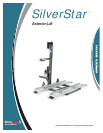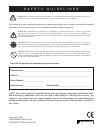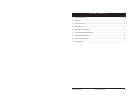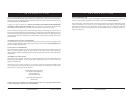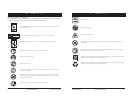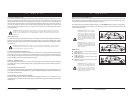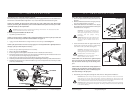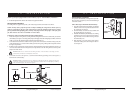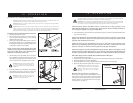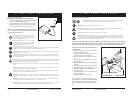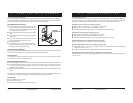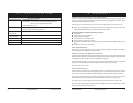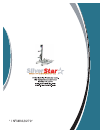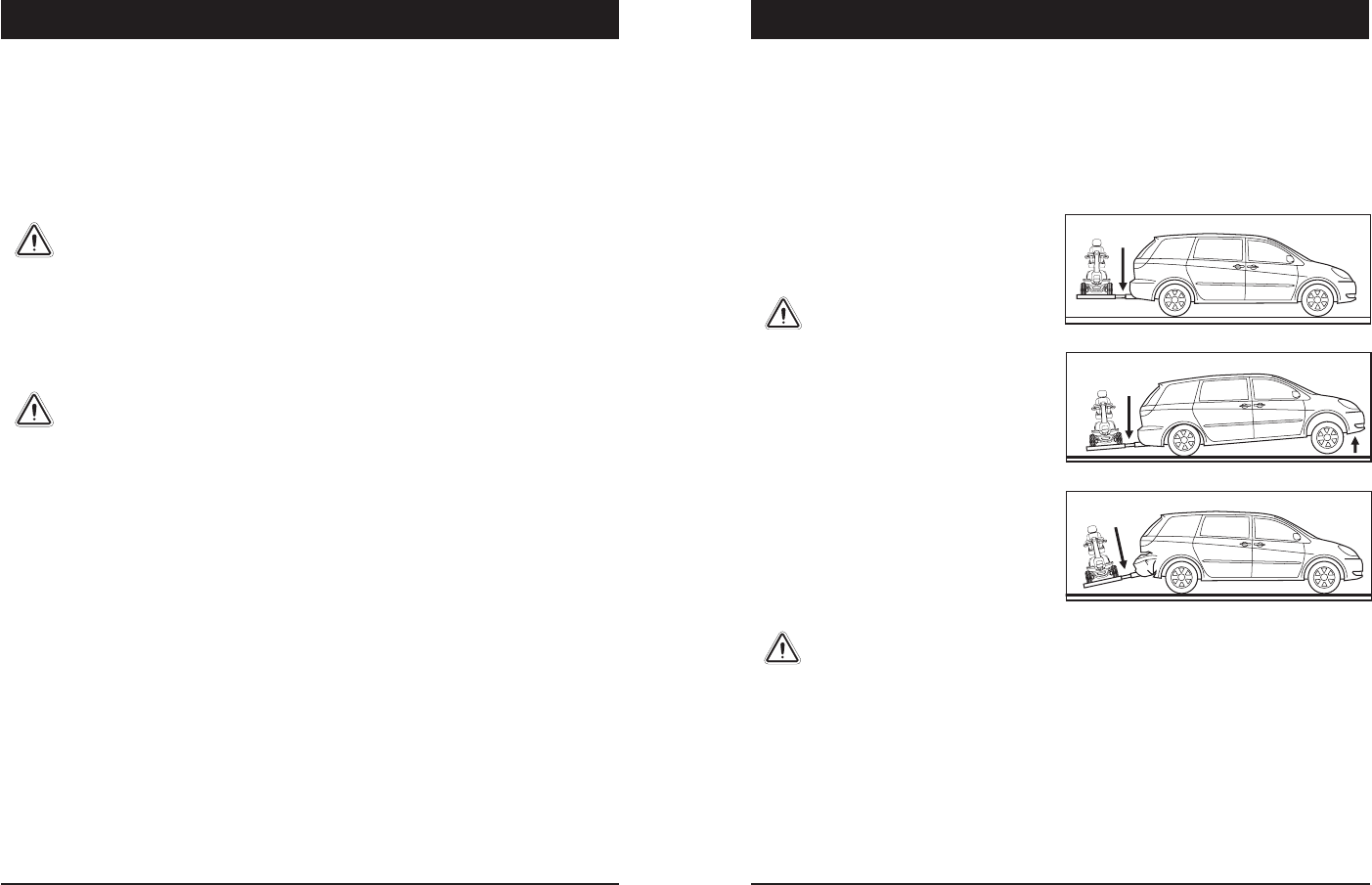
Exterior Lift System www.pridemobility.com 98 www.pridemobility.com Exterior Lift System
II. SAFETY
WARNING! Adding accessories,
oversize batteries, or a different
seat will increase the weight of
your mobility vehicle. Verify with
your authorized Pride Provider that
the total weight of your mobility
device, including additions, does
not exceed the maximum weight
allowance.
WARNING! Never exceed the
maximum lifting capacity of a lift
regardless of the class of hitch being
used. Doing so may cause lift and/or
vehicle damage.
Hitch Classes
! A Class I hitch has a maximum tongue weight of
200 lbs. (90.75 kg).
! A Class II hitch has a maximum tongue weight of
350 lbs. (158.75 kg).
! A Class III hitch has a maximum tongue weight
of 500 lbs. (225.75 kg).
! A Class IV hitch has a maximum tongue weight of
1200 lbs. (544.30 kg).
WARNING! Before installing the
(exterior) lift and applicable hitch
system, check your vehicle owner’s
manual for its hitch maximum
tongue weight capacity. Do not
exceed the maximum tongue weight
capacity of your vehicle.
HITCH CLASS INFORMATION
Hitches come in a variety of sizes and are designated by class. The classes range from Class I to Class IV. The
heavier the load, the larger class of hitch having a greater tongue weight needed. Tongue weight is the amount
of weight (downward force) the load puts on the hitch. See figure 1.
The combined weight of your lift and mobility vehicle gives you the minimum tongue weight for your application.
Exceeding the tongue weight of a hitch creates an unsafe driving situation and can damage the hitch and/or the
vehicle. See figures 2 and 3.
Figure 1. Tongue Weight Pressure Point
Figure 2. Unsafe Driving Situation
Figure 3. Vehicle Damage
LIFTING CAPABILITIES
The Exterior Lift System is an electromechanical device designed to lift various types of mobility devices for the
purpose of vehicle transport. The Exterior Lift System is designed for a maximum Class 2 hitch allowance of
190 lbs. (86 kg) and a maximum Class 3 hitch allowance of 325 lbs. (147 kg). Under no circumstances should
the Exterior Lift System be made to exceed this weight limit. Subjecting the lift system to the strain of hoisting
more than it is designed to lift may cause it to fail, resulting in damage to the mobility device and/or the lift
operator. Refer to the mobility device owner’s manual for information on the overall weight of the mobility
device before lifting.
WARNING! Adding accessories, oversize batteries, or a different seat will increase the
weight of your mobility device. Verify with your authorized Pride Provider that the total
weight of your mobility device, including additions, does not exceed the maximum hitch
allowance.
INSTALLATION
The Exterior Lift System is designed to be mounted to a vehicle hitch system. Before lift installation, ensure that the
hitch shows no signs of rust or wear and that the front and rear vehicle suspension is acceptable. If any vehicle
alterations are necessary, make sure that you fully understand the instructions for drilling or cutting before making
any alterations.
WARNING! Before drilling or cutting into the vehicle, make absolutely certain through
visual inspection that there are no obstructions in the path of the drill bit, such as the fuel
tank, exhaust pipes, or electrical wires.
LIFTING NON-PRIDE PRODUCTS
The Exterior Lift System is an extremely versatile device, which users may employ to lift items other than Pride
products. Pride has no control over such use, nor can Pride anticipate every possible use to which a lift system may
be put. Lifting non-Pride products with the Exterior Lift System is done at the operator’s own risk, and Pride
accepts no liability for damage or injury resulting from such use.
PRELIFT INSPECTION
Before operating the Exterior Lift System, inspect your surroundings to ensure that the lift system has a clear path
of operation. Remove any possible obstructions before operating the lift and do not allow children to operate or
play near the lift.
OPERATOR POSITIONING
The operator of the lift should stand a safe distance from the unit being lifted/lowered to ensure that his/her feet are
never positioned under the raised lift platform. The operator should also keep his/her hands clear of the lift system
to avoid the potential for injury.
TRANSPORT VEHICLE POSITIONING
Be sure your vehicle is parked on flat, level ground before attempting to load, lift, or remove a mobility device with
the Exterior Lift System. Make sure the vehicle emergency park brake is engaged before loading or unloading a
mobility device.
II. SAFETY



